The CBRE Global Real Estate Income Fund (IGR), a closed-end fund focused on global property assets, is attracting attention from income-oriented investors with its substantial distribution yield approaching 14%. As central banks around the world begin to lower interest rates, the fund's portfolio of real estate securities may be positioned for potential growth, complementing its high monthly payouts.
Despite trading at a premium to its net asset value, IGR has demonstrated strong performance relative to its peers and has maintained a consistent monthly distribution of $0.06 per share for over three years. This combination of high yield and potential capital appreciation in a shifting economic landscape makes it a subject of analysis for those seeking to diversify their income portfolios.
Key Takeaways
- The CBRE Global Real Estate Income Fund (IGR) currently provides a distribution yield of nearly 14% to investors.
- Lowering interest rates by global central banks are expected to create a favorable environment for real estate assets, potentially boosting IGR's holdings.
- IGR has maintained a stable monthly distribution of $0.06 per share for more than three years and has outperformed its peer group year-to-date.
- The fund invests in a diversified portfolio of global real estate investment trusts (REITs), with approximately 40% of its assets located outside the United States.
- Key risks include the fund's current trading premium of 4.5% over its net asset value (NAV) and broader global macroeconomic uncertainties.
A Closer Look at the IGR Fund
The CBRE Global Real Estate Income Fund, known by its ticker symbol IGR, operates as a closed-end fund with a dual mandate. Its primary objective is to generate high current income for its shareholders, while its secondary goal is capital appreciation. To achieve this, the fund invests in a global portfolio of real estate securities.
The fund's strategy involves allocating capital primarily to income-producing common and preferred stocks of real estate companies. According to its investment policy, IGR can invest up to 25% of its assets in preferred shares, which often provide stable dividend payments.
Portfolio Composition and Global Reach
A significant portion of IGR's strength lies in its diversified holdings. The fund provides exposure to real estate markets both within and outside the United States. While the majority of its assets are in U.S.-based companies, approximately 40% of the portfolio is invested internationally.
These international investments are spread across several developed markets, including:
- Japan
- United Kingdom
- Hong Kong
- Australia
- Singapore
- Canada
- Various European nations
This geographic diversification helps mitigate risks associated with any single country's economic performance and allows the fund to capitalize on growth opportunities worldwide. Many of these international markets are also experiencing declining interest rates, which could further support real estate valuations.
Top Holdings Concentration
The top 10 holdings in IGR's portfolio constitute nearly 50% of its total assets. This concentration includes well-known Real Estate Investment Trusts (REITs) such as Welltower (WELL), American Tower Corp. (AMT), Crown Castle Inc. (CCI), and Equinix (EQIX), which are also prominent in other major real estate funds.
Performance and Distributions in a Shifting Market
IGR has distinguished itself with consistent income generation and solid performance relative to its competitors. For income-focused investors, the fund's distribution history is a key point of attraction.
A Track Record of Stable Payouts
For the past three and a half years, IGR has paid a managed distribution of $0.06 per share each month. This consistency has been maintained through periods of economic volatility, including the recent era of rising interest rates. Over the last decade, the fund has increased its distribution twice without implementing any cuts, a notable achievement in the closed-end fund space.
This steady payout translates to a current distribution yield of nearly 14%, a figure that is significantly higher than many other income-oriented investments. This high yield is a primary reason why investors may consider the fund, especially in an environment where generating reliable income is a priority.
Relative Outperformance in 2025
On a year-to-date basis, IGR has substantially outperformed its peers in the real estate closed-end fund category. While the broader real estate sector, as measured by the Real Estate Select Sector SPDR Fund (XLRE), has traded sideways for much of the past year, IGR has delivered positive price returns, adding to its total return for shareholders.
The Impact of Declining Interest Rates
The global macroeconomic environment is a critical factor for the real estate sector. After a prolonged period of rate hikes to combat inflation, many central banks, including the U.S. Federal Reserve, have begun to lower interest rates. This shift is widely seen as a positive catalyst for real estate assets.
"Fed rate cuts could help bring mortgage rates lower, although interest rates already price in expectations of some rate cuts. If mortgage rates decline and real income growth remains healthy, it could support housing demand and help offset higher supply." - U.S. Bank Investment Insight
Lower interest rates generally reduce borrowing costs for real estate companies, making it cheaper to finance property acquisitions and development projects. This can improve profitability and cash flow, which in turn supports higher property valuations and dividend payments. For funds like IGR, this environment can lead to both higher income and capital appreciation of its underlying holdings.
Recent analysis from Jones Lang LaSalle (JLL) on the 2025 global real estate outlook highlights resilience and agility as key themes. The report notes that while geopolitical and economic risks remain, factors like low valuation risk and falling credit costs are creating a foundation for recovery.
Valuation and Potential Risks
While the outlook for IGR appears favorable, investors should consider several risks, including its current valuation and broader market uncertainties.
Trading at a Premium
IGR currently trades at a premium to its net asset value (NAV) of approximately 4.5%. The NAV represents the underlying value of the fund's assets per share. A premium indicates that the market price of the fund's shares is higher than this intrinsic value.
This premium suggests that market participants are optimistic about the fund's future, likely pricing in the positive effects of lower interest rates. However, it also presents a risk. Closed-end funds that typically trade at a discount can experience a price correction if they revert to their historical average. A market downturn could cause the premium to shrink or disappear, leading to a decline in the share price even if the NAV remains stable.
Broader Macroeconomic Headwinds
Despite the positive impact of lower rates, the global economy faces persistent challenges. Geopolitical uncertainty, ongoing trade disputes, and the potential for resurgent inflation could create downside pressure on global real estate markets. The fund's 2024 annual report noted that investor caution in the latter half of the year was driven by a less robust economic landscape outside the U.S. and the potential impact of trade tariffs.
These global macro conditions could slow or even derail the recovery in real estate. Therefore, while IGR offers a compelling income opportunity, it is not without exposure to systemic market risks. Investors should consider it as part of a diversified portfolio rather than a standalone investment.





